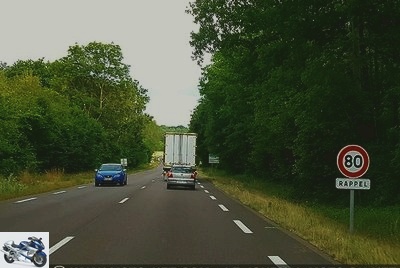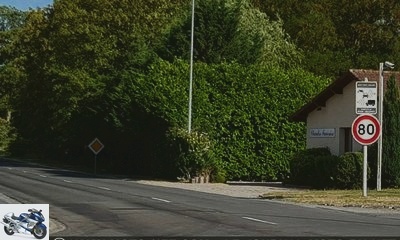60 private radar cars in Brittany, Pays de la Loire and Center-Val de Loire

No less than 60 unmarked cars equipped with radar will crisscross the roads of the Brittany, Pays de la Loire and Center-Val de Loire regions from January 2020. Their particularity ? As for a year in Normandy with more or less success, they will be led by a private operator and not a police officer or a gendarme. Explanations.
A private company responsible for observing speeding via a radar stashed in an unmarked car: it is not in the United States but in France, on the initiative in spring 2018 of the interministerial delegate for road safety Emmanuel Barbe.
But what are the police doing ?! "They devote themselves to tasks where it is essential for them to intercept the motorist: blood alcohol control, narcotics, etc.", answers the State to justify the privatization of this task traditionally devolved to the police. . Until the day when these prevention and protection missions will also be the responsibility of a private company ?!
- MNC of February 27, 2017 :
- MNC of April 24, 2018 :
Still, this "outsourcing" brings all satisfaction, in particular – and above all? – on an economic level: these famous radar cars previously required two police or gendarmerie officials, so that now a single private operator is sufficient! The savings made makes sense…
Not to mention that the State takes the opportunity to demand a strong return on investment volume of presence since "these vehicles are intended to carry out speed checks 6 hours a day, 7 days a week, 24 hours a day". An hourly amplitude impossible to reach by the police in charge of other missions.
Road safety does not deprive itself of anything
Entrusted to the Mobiom company, the first private radar cars made their appearance in Normandy and will soon be joined by "60 unmarked vehicles" distributed almost equally over the regions of Brittany (19 cars), Pays de la Loire (20) and Center-Val de Loire (21).

Their entry into circulation is scheduled "from January 2020" and three different companies – one per region – will be appointed through a call for tenders to "preserve competition". Yes, as for the assignment of a construction site !
"As in Normandy, the companies that will be appointed at the end of the second call for tenders will be remunerated according to the number of kilometers of checks carried out", recalls the Road Safety Delegation, (DSR) often attacked as regards transparency – even the legality – of these outsourced controls.
- !
"The journeys made and the time slots for checks are set by the State services (…) and are in no way left to the free appreciation of companies or their drivers. Similarly, companies are not paid to the number of recorded offenses ", defends the DSR.
"Technical difficulties inherent in any innovation"
But if the Ministry of the Interior – in charge of Road Safety – is rubbing its hands at the idea of extending the areas covered by private radar cars, the question arises of their efficiency and profitability….
- MNC of February 5, 2019 : The first unconvincing assessment of private radar cars
The first assessment of their deployment in Normandy turned out to be much less brilliant than expected, due to under-use of the affected vehicles and the low daily mileage achieved by external operators. Far from the initial project of flashing every day in "H-24" !
The DSR refers to "technical difficulties inherent in any technological innovation" which would henceforth be "resolved" by the "current system". And delivers impressive figures to support his point: "more than 800 tours" have been made since the first quarter of 2019 by these private radar cars, or "about 200,000 kilometers of control".
These checks generated nearly "12,000 infringement messages", continues the government body, calculating that the share of excess of more than 20 km / h recorded by these unmarked vehicles is "30% higher than that of fixed speed cameras" . This observation constitutes in his eyes "the proof of their effectiveness in the fight against excessive speeding".
Private radar cars, how does it work ?
Private radar cars control – while driving – the speed of vehicles crossed and which pass them via a specific radar placed in front and oriented to the left. The latter uses an infrared flash – unlike fixed cabins – which makes the offense undetectable by the offender.

This radar automatically determines the pace to be observed using on-board GPS, while cameras in the front and rear of the vehicle read road signs in real time to confirm the accuracy of the speed to be monitored. No human intervention is required: just turn on the device and enter the traffic.
The operator behind the wheel – in civilian clothes, as anonymous as the unmarked car – follows a precise route indicated by a GPS navigation system and has no access to the recorded data: these are transmitted in encrypted form to the National Center for processing of offenses (CNT) in Rennes.
"In fact, when the radar car is on the road, its driver is unaware of the activity of detecting speeding, completely autonomous", assures the Road Safety by adding that the company holding the market "can neither access the pictures verbalization, nor know the number of infractions noted by the vehicles for which it is responsible while driving ".
Cash for flashes
The remuneration of these private operators is based on a number of kilometers to be checked each day. The service provider is therefore not directly paid "in the flash" and does not obtain anything more by doing more distance: "not only will he not see his remuneration increase but he will have to pay a heavy fine", even threatens the DSR.
What if he does less? His remuneration will be "reduced by as much", indicates the Delegation for road safety which determines with the prefectures concerned a precise and limited number of routes to be carried out each day..
Remember that the margin of error of these on-board radars is twice that of fixed radars: 10 km / h for speeding less than 100 km / h and 10% above. Finally, some offending drivers accuse the operator of knowingly driving below the limit to encourage him to exceed it … and trigger the radar !
Related articles
-
Radars – Privatization of on-board radars: everything you need to know about private radar cars –
Privatization of on-board radars: all you need to know about private radar cars Before generalizing throughout France the privatized radar cars which…
-
Radars – The first unconvincing assessment of private radar cars –
The first unconvincing assessment of private radar cars The Ministry of the Interior delivers the first official report of the radar cars entrusted to…
-
Radars – What is the speed retained by the new private radar cars? –
What is the speed retained by the new private radar cars? ? Proud to announce its new private radar cars without human intervention , the Ministry of the…
-
Radars – The legality of private radar cars questioned … by the Ministry of the Interior! –
The legality of private radar cars questioned … by the interior ministry ! Based on an internal note from the Ministry of the Interior published by Le…
-
Radars – Large digital demonstration against private radar cars –
Big digital demonstration against private radar cars To protest against the privatization of on-board radar checks which begins this Friday – and to deal…
-
Hidden radars, fluorescent vest and large plates for motorcycles The Interministerial Road Safety Committee (IRB) held this morning in Paris is going up…
-
Radars – Radar warning devices: agreement between AFFTAC and Gueant –
Radar warning devices: agreement between AFFTAC and Gueant Demonized by the thinking heads of the IRB (read our IRB File), the manufacturers of radar…
-
Radars – Radar warning devices prohibited: AFFTAC on the offensive –
Radar warning devices prohibited: AFFTAC on the offensive Gathered this morning at the headquarters of the Automobile Club in Paris, the three major…
-
Radars – Bol d’Or: two autonomous radars to welcome bikers in the Var –
Bol d’Or: two autonomous radars to welcome bikers in the Var To welcome motorcyclists for the Bol d’Or 2015, this weekend on the Castellet circuit (83),…
-
Radars – Road Safety excludes any cancellation of speeding in the event of a return to 90 km-h –
Road Safety excludes any cancellation of speeding in the event of a return to 90 km / h While the 90 km / h limit could soon make a comeback in the…